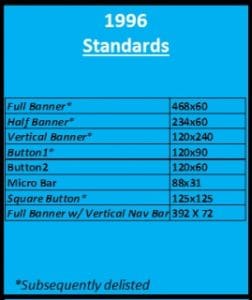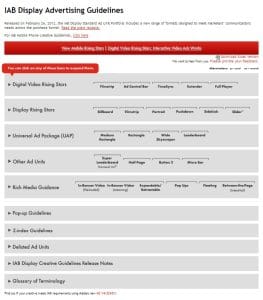Imagine opening your web browser to catch up on the daily news only to find yourself scrolling forever to find the information. Now imagine trying to read that information amongst an array of online display banners, pop-ups and auto-initiated video. The internet would quickly become frustrating and time consuming as opposed to being a quick, informative tool.
We may take it for granted, but if standards and guidelines governing online display advertising had not been created, the delicate balance between displaying a marketing message and the user’s experience on a website would have quickly fallen apart. Without a doubt, the digital world would be a much different landscape then it is today.
Luckily for digital marketers and users alike, in 1996 the Internet Advertising Bureau (IAB) was formed to do just this. The IAB is a non-profit organization that was founded in New York, NY. The initial goal of the IAB was to standardize online display advertising to achieve balance between the banner ads being displayed and the content the end user was viewing. Today the IAB is a global organization with over 600 members worldwide.
Before the IAB’s formation there were no set sizes for online digital display advertising. A marketing campaign could be launched on 20 different websites and have 20 different sizes of creative that needed to be produced, approved and submitted. All very time-consuming for the agency/graphic designer and costly to businesses.
In 1996, the first set of online display advertising standards were released. They included eight set sizes and looked something like this.
Minnium, P. (September 3, 2014). Geeking Out On Digital Ads: A Definitive History Of IAB Standards. Retrieved from http://marketingland.com/geeking-digital-ads-definitive-history-iab-standards97204
Ad sizes with a (*) were removed afterwards.
What started out as eight standards in 1996 has grown to include over 33 different creative standards across multiple platforms. It is estimated that over 80% of display ads currently sold follow IAB standards. Today, if you click on the Display Advertising Guidelines under the Guidelines & Best Practices tab on IAB’s website, you will see something like this.
It’s a huge demonstration on how much online technology has evolved since 1996 and how the digital marketing industry has transformed along with it.
In addition to advertising standards, the IAB’s scope has expanded to include research into digital marketing best practices as well as legal support to businesses and individuals in the digital marketing industry.
The research that IAB undertakes involves everything from engagement of online display advertising and effectiveness of video and TV advertising to how to protect brands against piracy websites. This research helps to educate online marketers, form future guidelines and standards, and assists in the creation of more effective advertising placements.
Any business that is considering including online advertising as a revenue generator for their website would be wise to align itself with the standards and guidelines the IAB sets out. Adherence will make it much easier for online inventory to be sold on your site and will also put you on a level playing field with the larger players.
If you are unfamiliar with the IAB and would like to learn more, go to www.iab.net and look around. There you will find many resources which are both interesting and helpful. One of these resources is the “Rising Stars” advertising units. Rising Stars is comprised of the newest advertising units using the latest technology and most innovative creative in display, mobile and video advertising.
A greater understanding and knowledge of online display advertising may have you changing your mind about those banners you see when scrolling through your favourite sites. In fact, the next time you hit “close” on the online advertisement that just announced the current lotto jackpot or “skip ad” on the YouTube video you’re watching, you may just find yourself taking a moment to reflect on how the standards governing that “close” or “skip” option came to pass and how different your experience of the internet would be without them. Who knows? You may even come up with an idea for a “Rising Star” of your own!












